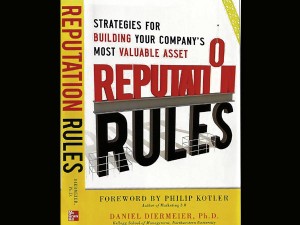CEOs: Don’t abdicate brand risk handling to lawyers

High in the agenda of lawyerly thinking is to address the “liability issue,” when the all-important issue should be protecting corporate or product image – or both.
In the not so distant past, a giant petroleum company figured in an environmental damage incident, and the wise move should have been for the CEO to come forward and take charge of the situation. He was, however, advised by the legal counsel to “wait it out,” because having a high profile role in mitigating the accident could be “an admission of liability.”
When the company finally had to make public its stand, this statement was issued: “We take full responsibility for the incident, but we are not accepting liability.” Only the hair-splitting skills of a lawyer could have crafted such an adroitly evasive statement, and only the unerring eye and healthy skepticism of media could expose such a “neither-nor-there” statement.
A recently published book, “Reputation Rules: Strategies for Building Your Company’s Most Valuable Asset,” calls for a judicious balancing act by the CEO, who should provide “crisis leadership” during situations of acute danger involving company operations or its product.
“A CEO needs to balance many risks, but in a reputational crisis, two of these are usually particularly at odds: legal and brand risk,” says Daniel Diermeier, Ph.D., book author and professor of Kellogg School of Management.
Dr. Diermeier faults the CEO, not the lawyer: “The general counsel should always play an important role during a reputational crisis. The problem, however, lies in the CEO’s mindlessly abdicating his responsibility to the legal department.”
This book is not really a treatise against abdicating the CEO throne to the lawyers. It is actually a compelling argument that the CEO as top of executive of the organization must assume a “take charge position” in times of crisis, and must summon all relevant functions to come to the defense of the company’s reputation.
From the perspective of squarely laying the risk handling task to the CEO, the author also advises against relying on the public relations expert alone for “damage control,” while acknowledging corporate communication’s role in “amplifying positive messages” for media.
I recall an exchange between me and topnotch lawyer Francis Jardeleza (now deputy ombudsman) who wisely delineated the role of the lawyer and the communication man in times of crisis or controversy: “Lawyers will handle the court of law, communicators will take care of the court of public opinion.” The CEO who recognizes such a distinction can harness each discipline’s power to the full.
The author, demonstrating remarkable scholarship, offers an abundance of conceptual models that make it easy for executives to understand either new concepts – or things CEOs are intuitively doing but are now rationally presented in easy-to-understand frameworks. Good Ph.D.’s actually simplify things, boiling otherwise incomprehensible jargon to the elemental. (Bad Ph.D.’s, admittedly, really complicate simple truths.)
The book presents one useful model – the “Trust Radar,” a quadrant that shows four essential elements in winning and building trust. These are Transparency, Expertise, Commitment and Empathy. I tested this radar recently with a group, and it has made it easy to spot trust-building or trust trashing executive conduct. For example, the company may show Expertise in dealing with a situation, but it may lack Transparency (because of the impression that it is hiding something).
Or, the company may demonstrate Commitment in solving a problem by deploying no less than its CEO, but such resolve in assuming responsibility is neutralized by the executive’s utter lack of caring, which makes him score low in Empathy.
Dr. Diermeier walks the reader through many examples in the US, Europe and Japan on how CEOs handled or mishandled a product recall, an environmental disaster, a financial reporting wrongdoing, etc., and brings out lessons from cases of success or failure in the reputation turnaround business.
He reminds executives that reputation crisis management is much more than “damage control” or “getting the incident out of the headlines.” He quotes Lloyd Blankfein confession [made in 2010 after the firm’s crisis] to emphasize a point that reputation care must do much more: “As for leadership, I have to hold myself accountable for the positives and the negatives. We did a good job managing risk; but we did a less good job managing our reputation.”
The author recommends integrating reputation management into the strategic and operational processes of the organization. He gives the first option: Create the position of a “chief reputation officer [CRO] or chief reputation risk officer [CRRO].” Second option: Create a “Corporation Reputation Council” (CRC), a cross functional unit of senior executives. The pros and cons of two options are discussed at length in the 295-page book.
Finally, the book stresses that every reputational crisis is a “teachable moment.” An old adage rings true even today: “Those who do not learn from the lesson of the past are doomed to repeat it.” A crisis need not lead to disaster or doom. A company can rise from a near-fall. It’s a cliché, and yet such a cliché may clinch a survival for a firm. Or even lead to a dramatic turnaround if not a decisive corporate triumph. (dmv.communications@gmail.com)
